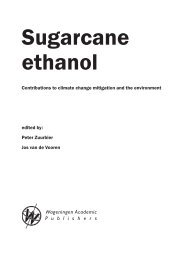Production and use of fuel ethanol in Brazil - BAFF
Production and use of fuel ethanol in Brazil - BAFF
Production and use of fuel ethanol in Brazil - BAFF
You also want an ePaper? Increase the reach of your titles
YUMPU automatically turns print PDFs into web optimized ePapers that Google loves.
54<br />
Beca<strong>use</strong> there is a tendency to exam<strong>in</strong>e the <strong>in</strong>creased volatility <strong>of</strong> the blend<br />
separately, which <strong>of</strong>ten results <strong>in</strong> exaggerations <strong>of</strong> the magnitude <strong>of</strong> its impact, it is<br />
advisable to conduct the analysis with<strong>in</strong> the context <strong>of</strong> the total pollutant emissions<br />
from the fleet <strong>of</strong> vehicles be<strong>in</strong>g considered. Such new attitude will show that while<br />
this k<strong>in</strong>d <strong>of</strong> emission can <strong>in</strong>crease, the benefits provided by the addition <strong>of</strong> <strong>ethanol</strong><br />
with a view to reduc<strong>in</strong>g pollutants <strong>in</strong> the exhaust gas plentifully compensate for the<br />
negative effect.<br />
B4.5.<br />
Is it true that the <strong>ethanol</strong> produced from<br />
sugar-cane <strong>in</strong> <strong>Brazil</strong> is much more efficient<br />
than that produced from corn (or other cereals)<br />
<strong>in</strong> other countries as a greenho<strong>use</strong> effect<br />
mitigat<strong>in</strong>g factor?<br />
As mentioned <strong>in</strong> item 1.3 for sugar-cane, the ratio between the renewable energy<br />
produced <strong>and</strong> the fossil energy <strong>use</strong>d was 8.9 for <strong>ethanol</strong> (2005) <strong>in</strong> <strong>Brazil</strong>, which is<br />
nearly five times better than the corn <strong>ethanol</strong> ratio.<br />
While GHG emissions result<strong>in</strong>g from the <strong>use</strong> <strong>of</strong> fossil <strong>fuel</strong>s <strong>in</strong> the production <strong>of</strong> that<br />
bi<strong>of</strong>uel are not the only ones <strong>in</strong> the process, they are much more important than<br />
the others; this is why GHG emissions from <strong>ethanol</strong> production, as it is <strong>in</strong> <strong>Brazil</strong>,<br />
are around four times lower than <strong>in</strong> most countrieswhere <strong>ethanol</strong> is produced from<br />
corn, gra<strong>in</strong> or cassava.<br />
The result is the extraord<strong>in</strong>ary performance <strong>of</strong> the <strong>in</strong>dustry, avoid<strong>in</strong>g GHG emissions<br />
equivalent to 13 percent <strong>of</strong> those from <strong>Brazil</strong>’s entire energy sector (base 1994).<br />
For example, the GHG emissions avoided by the sector <strong>in</strong> 2003 were as follows:<br />
for <strong>ethanol</strong> replac<strong>in</strong>g gasol<strong>in</strong>e:<br />
27.5 million tons <strong>of</strong> CO 2 equivalent<br />
for cane bagasse <strong>in</strong> sugar production:<br />
5.7 million tons <strong>of</strong> CO 2 equivalent<br />
B. Sugar-cane <strong>and</strong> <strong>ethanol</strong> production: environmental aspects












